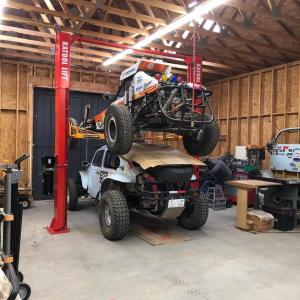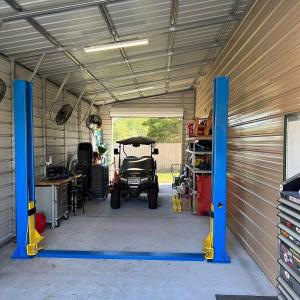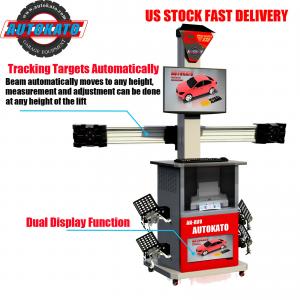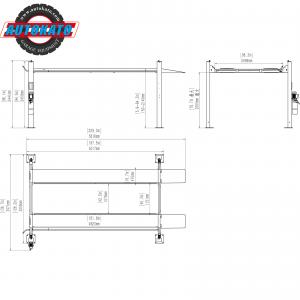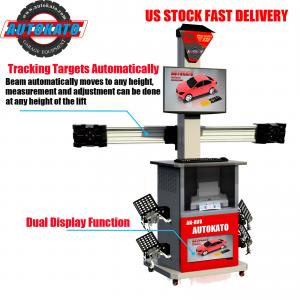Choose the Right Lift and Accessories for the Job
Not every lift is a good fit for every job. That’s why most professional garages have more than one type of lift installed. Before you pull a vehicle into a bay, make sure the lift is suited to the job at hand. Consider the lift’s rated load capacity, clearances and ability to reach the vehicle manufacturer-recommended lifting points. Never overload a lift. As with any project, match the proper equipment to the task.
It’s also important to use the right accessories. For example, with some two-post lifts, you may need height adapters to reach the lifting points on pickup trucks or the manufacturer may recommend pad adapters for picking up unibody vehicles. Never make your own adapters or use wood blocks in their place. This is dangerous and potentially voids your lift’s certification.
Lift adapters, options and accessories are required to be manufactured in compliance with ANSI/ALI ALCTV (current edition) Standard for Automotive Lifts “Safety Requirements for Construction, Testing and Validation,” and certified or listed for use on a specific lift. All items certified for use with each hoist is included in the ALI Directory of Certified Lifts. ALI recommends using only adapters provided by the manufacturer of your lift.
Get Lift Operation Training
You probably already know the basics of how to use a car lift. However, not all lifts are the same. Training on how to properly use your lift is crucial to safe lifting. Be sure you’ve been trained and are familiar with the manufacturer’s instructions for a lift before you use it, especially if you’re using a new or different model than you’re used to. Review all lift safety materials, including the warning labels. Always follow the lift manufacturer’s instructions on how to operate the lift, including any safety features.
Training should be based on the lift manufacturer-provided instructions and warning labels, as well as the ALI publications Quick Reference Guide, Vehicle Lifting Points for Frame-Engaging Lifts, Lifting It Right, Safety Tips and the ANSI/ALI ALOIM (current edition) Standard for Automotive Lifts “Safety Requirements for Operation, Inspection and Maintenance.” Training should be documented – proof may be required during health and safety or insurance inspections.
Lift It Right
The overwhelming reasons vehicles fall from lifts are because technicians miscalculate the center of gravity, don’t spot vehicles properly or fail to chock the wheels.
Before you a lift a vehicle, you need to know where its center of gravity is. If you’re using a frame-engaging lift like a two-post lift or an axle-engaging lift like some inground lifts, you also need to check the vehicle manufacturer’s recommended lifting points. These are the points identified by the vehicle OEM as the appropriate place for the lift to contact the vehicle.
When spotting the vehicle on the lift, use any devices supplied by the lift manufacturer to help properly position the car, truck or van for lifting. Once the vehicle is in position, turn it off, close all doors and make sure no one is in the bay. If using a drive-on lift, put the vehicle in park or in gear and chock the tires.
For frame-engaging and pad lifts like two-post lifts, once the vehicle is properly spotted, raise the lift until the adapters or other supports just contact the vehicle. Stop to make sure all adapters are securely contacting the vehicle’s recommended lifting points. Then raise the vehicle again until the tires clear the floor. Shake the vehicle moderately to confirm stability. Visually check all the lifting points again.
Once the vehicle is confirmed to be stable, raise it to the desired working height and then lower the load onto the lift’s load-holding device (also known as a lock or latch). Visually check the contact points once more to make sure each adapter is securely in position before going under the vehicle.
Whenever you’re using a lift, stay at the controls throughout the lifting and lowering process. Never block, override or disable the controls, features or safety devices. What may save you a few seconds could cause a serious accident. Remember, your safety is riding on it.
ALI’s exclusive online training course Lifting It Right explains the right way to lift a vehicle without causing injury or property damage. It provides more detail on spotting and lifting a vehicle. It also covers additional topics like preparing the service bay, maintaining load stability, lowering the lift and lift maintenance.
